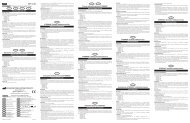® RMT THERMOCOOL ® Diagnostic/Ablation Steerable Tip Catheter
® RMT THERMOCOOL ® Diagnostic/Ablation Steerable Tip Catheter
® RMT THERMOCOOL ® Diagnostic/Ablation Steerable Tip Catheter
Create successful ePaper yourself
Turn your PDF publications into a flip-book with our unique Google optimized e-Paper software.
Instructions for Use NAVISTAR <strong>®</strong> <strong>RMT</strong> <strong>THERMOCOOL</strong> <strong>®</strong> <strong>Diagnostic</strong>/<strong>Ablation</strong> <strong>Steerable</strong> <strong>Tip</strong> <strong>Catheter</strong><br />
13. Verify that the CATHETER SELECTION KNOB on the Stockert 70 RF Generator is on the “ThermoCool” option. When this<br />
option is chosen, the Stockert 70 RF generator defaults to the safety parameters established for the <strong>THERMOCOOL</strong> <strong>®</strong><br />
<strong>Catheter</strong>.<br />
14. Recommendation for irrigation: Increase the irrigation to high flow rate starting up to 5 seconds before the onset of RF<br />
energy delivery and maintaining this higher flow rate until 5 seconds after termination of the energy application. For power<br />
levels up to 30 watts, a high flow rate of 17ml/min should be used. For power levels between 31-50 watts, a high flow rate<br />
of 30ml/min should be used.<br />
15. The application of RF energy must not be initiated until the increase in irrigation flow rate is confirmed by a minimum of 2º<br />
C decrease in tip electrode temperature.<br />
16. Monitor the catheter tip temperature throughout the procedure to ensure adequate irrigation. If the temperature increases to<br />
50º C during RF application, power delivery will be interrupted by the temperature cutoff of the Stockert 70 RF Generator.<br />
The irrigation system must be rechecked prior to restarting RF application.<br />
17. Recommendation for RF power delivered:<br />
For treatment of atrial flutter: Start a procedure at 15 - 20 Watts. After 15 seconds, power may be increased by 5 - 10 W<br />
increments as needed, until a transmural lesion is achieved, defined by > 80% reduction in unipolar atrial electrogram<br />
amplitude, or emergence of double potentials of equal and low amplitude. It is recommended that power not exceed 50 W<br />
when the catheter is parallel to the tissue and 35 W if the catheter is perpendicular to the tissue. The duration of each RF<br />
application should not exceed 120 seconds. Dragging the catheter to the next site is permissible during the 120 second<br />
energy application. RF current may be reapplied to the same or alternate sites using the same catheter.<br />
For treatment of ventricular tachycardia: Start a procedure at 31 Watts. If needed, increase power in 5 W increments (to<br />
maximum 50 W) until a transmural lesion is achieved. The duration of each RF application should not exceed 120 seconds.<br />
Dragging the catheter to the next site is permissible during the 120 second energy application.<br />
18. Prior to removal of the catheter, confirm that the magnetic fields are removed.<br />
19. In the event of a generator cutoff (impedance or temperature), the catheter must be withdrawn and the tip electrode cleaned<br />
of coagulum, if present before RF current is reapplied. A sterile gauze pad dampened with sterile saline may be used to<br />
gently wipe the tip section clean; do not scrub or twist the tip electrode as damage to the tip electrode bond may occur and<br />
loosen the tip electrode. Prior to reinsertion, ensure that the irrigation holes are not plugged by increasing flow rate and<br />
verifying flow from each of the six irrigation holes.<br />
If irrigation hole occlusion occurs:<br />
a. Fill a 1 or 2 ml syringe with sterile saline and attach to the stopcock on the end of the tubing set<br />
b. Carefully inject the saline from the syringe into the catheter. A stream of fluid should be visible from all six (6) holes.<br />
c. Repeat steps a and b, if necessary until the holes are cleared.<br />
d. Flush catheter and tubing per standard technique to ensure purging of trapped air bubbles and to verify that the<br />
irrigation holes are patent.<br />
e. The catheter can now be reintroduced into the patient<br />
WARNING: Do not continue use of the catheter if still occluded or it is not functioning properly.<br />
DISCLAIMER OF WARRANTY AND LIMITATION OF LIABILITY<br />
THERE IS NO EXPRESS OR IMPLIED WARRANTY, INCLUDING WITHOUT LIMITATION ANY IMPLIED WARRANTY OF<br />
MERCHANTABILITY OR FITNESS FOR A PARTICULAR PURPOSE, ON THE PRODUCT(S) DESCRIBED HEREIN. UNDER<br />
NO CIRCUMSTANCES SHALL BIOSENSE WEBSTER, INC., OR ITS AFFILIATED COMPANIES, BE LIABLE FOR ANY<br />
SPECIAL, DIRECT, INCIDENTAL, CONSEQUENTIAL, OR OTHER DAMAGES OTHER THAN AS EXPRESSLY PROVIDED<br />
BY SPECIFIC LAW.<br />
WITHOUT LIMITING THE FOREGOING, BIOSENSE WEBSTER, INC. OR ITS<br />
AFFILIATED COMPANIES, SHALL NOT BE LIABLE FOR ANY SPECIAL, DIRECT, INCIDENTAL, CONSEQUENTIAL, OR<br />
OTHER DAMAGES, ARISING OUT OF THE REUSE OF ANY PRODUCT(S) LABELED FOR SINGLE USE OR WHERE<br />
REUSE IS PROHIBITED BY APPLICABLE LAW.<br />
Descriptions and specifications appearing in Biosense Webster, Inc. printed matter, including this publication, are informational<br />
only and meant solely to generally describe the product at the time of manufacture and are not made or given as a warranty of<br />
the prescribed product in any way.<br />
22 M-5276-459C



